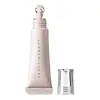What's inside
What's inside
 Key Ingredients
Key Ingredients

 Benefits
Benefits

 Concerns
Concerns

 Ingredients Side-by-side
Ingredients Side-by-side

Caprylic/Capric Triglyceride
MaskingWater
Skin ConditioningCera Microcristallina
Emulsion StabilisingSynthetic Wax
AbrasiveC9-12 Alkane
SolventTridecyl Trimellitate
EmollientPropanediol
SolventMica
Cosmetic ColorantPolyglyceryl-3 Diisostearate
EmulsifyingGlycerin
HumectantButylene Glycol
HumectantPolyglyceryl-6 Polyricinoleate
EmulsifyingSodium Chloride
Masking3-O-Ethyl Ascorbic Acid
Skin ConditioningTetrahexyldecyl Ascorbate
AntioxidantCaffeine
Skin ConditioningTocopherol
AntioxidantPoncirus Trifoliata Fruit Extract
Skin ConditioningCitrus Nobilis Fruit Extract
MaskingCitrus Paradisi Peel Extract
PerfumingJojoba Esters
EmollientEthylhexylglycerin
Skin ConditioningSodium Phytate
Polysilicone-11
Phenoxyethanol
PreservativeTin Oxide
AbrasiveIron Oxides
CI 77891
Cosmetic ColorantCaprylic/Capric Triglyceride, Water, Cera Microcristallina, Synthetic Wax, C9-12 Alkane, Tridecyl Trimellitate, Propanediol, Mica, Polyglyceryl-3 Diisostearate, Glycerin, Butylene Glycol, Polyglyceryl-6 Polyricinoleate, Sodium Chloride, 3-O-Ethyl Ascorbic Acid, Tetrahexyldecyl Ascorbate, Caffeine, Tocopherol, Poncirus Trifoliata Fruit Extract, Citrus Nobilis Fruit Extract, Citrus Paradisi Peel Extract, Jojoba Esters, Ethylhexylglycerin, Sodium Phytate, Polysilicone-11, Phenoxyethanol, Tin Oxide, Iron Oxides, CI 77891
Water
Skin ConditioningDimethicone
EmollientIsododecane
EmollientPEG-10 Dimethicone
Skin ConditioningGlycerin
HumectantDimethicone/Vinyl Dimethicone Crosspolymer
Skin ConditioningPolymethylsilsesquioxane
Trimethylsiloxysilicate
EmollientPEG/PPG-18/18 Dimethicone
EmulsifyingSodium Chloride
MaskingDisteardimonium Hectorite
StabilisingSodium Potassium Aluminum Silicate
Phenoxyethanol
PreservativePotassium Sorbate
PreservativeSodium Dehydroacetate
PreservativeAluminum Hydroxide
EmollientHydroxyethylcellulose
Emulsion StabilisingSilica
AbrasiveTriethoxycaprylylsilane
Pentylene Glycol
Skin ConditioningSimmondsia Chinensis Seed Oil
EmollientCitric Acid
BufferingFructose
HumectantSodium Hydroxide
BufferingUrea
BufferingSodium Hyaluronate
HumectantAllantoin
Skin ConditioningMaltose
MaskingSodium Lactate
BufferingSodium PCA
HumectantTrehalose
HumectantGlucose
HumectantDisodium Phosphate
BufferingPolysorbate 60
EmulsifyingSodium Phosphate
BufferingIron Oxides
CI 77891
Cosmetic ColorantCI 77163
Cosmetic ColorantWater, Dimethicone, Isododecane, PEG-10 Dimethicone, Glycerin, Dimethicone/Vinyl Dimethicone Crosspolymer, Polymethylsilsesquioxane, Trimethylsiloxysilicate, PEG/PPG-18/18 Dimethicone, Sodium Chloride, Disteardimonium Hectorite, Sodium Potassium Aluminum Silicate, Phenoxyethanol, Potassium Sorbate, Sodium Dehydroacetate, Aluminum Hydroxide, Hydroxyethylcellulose, Silica, Triethoxycaprylylsilane, Pentylene Glycol, Simmondsia Chinensis Seed Oil, Citric Acid, Fructose, Sodium Hydroxide, Urea, Sodium Hyaluronate, Allantoin, Maltose, Sodium Lactate, Sodium PCA, Trehalose, Glucose, Disodium Phosphate, Polysorbate 60, Sodium Phosphate, Iron Oxides, CI 77891, CI 77163
 Reviews
Reviews

Ingredients Explained
These ingredients are found in both products.
Ingredients higher up in an ingredient list are typically present in a larger amount.
Ci 77891 is a white pigment from Titanium dioxide. It is naturally found in minerals such as rutile and ilmenite.
It's main function is to add a white color to cosmetics. It can also be mixed with other colors to create different shades.
Ci 77891 is commonly found in sunscreens due to its ability to block UV rays.
Learn more about CI 77891Glycerin is already naturally found in your skin. It helps moisturize and protect your skin.
A study from 2016 found glycerin to be more effective as a humectant than AHAs and hyaluronic acid.
As a humectant, it helps the skin stay hydrated by pulling moisture to your skin. The low molecular weight of glycerin allows it to pull moisture into the deeper layers of your skin.
Hydrated skin improves your skin barrier; Your skin barrier helps protect against irritants and bacteria.
Glycerin has also been found to have antimicrobial and antiviral properties. Due to these properties, glycerin is often used in wound and burn treatments.
In cosmetics, glycerin is usually derived from plants such as soybean or palm. However, it can also be sourced from animals, such as tallow or animal fat.
This ingredient is organic, colorless, odorless, and non-toxic.
Glycerin is the name for this ingredient in American English. British English uses Glycerol/Glycerine.
Learn more about GlycerinPhenoxyethanol is a preservative that has germicide, antimicrobial, and aromatic properties. Studies show that phenoxyethanol can prevent microbial growth. By itself, it has a scent that is similar to that of a rose.
It's often used in formulations along with Caprylyl Glycol to preserve the shelf life of products.
Chances are, you eat sodium chloride every day. Sodium Chloride is also known as table salt.
This ingredient has many purposes in skincare: thickener, emulsifier, and exfoliator.
You'll most likely find this ingredient in cleansers where it is used to create a gel-like texture. As an emulsifier, it also prevents ingredients from separating.
There is much debate on whether this ingredient is comedogenic. The short answer - comedogenic ratings don't tell the whole story. Learn more about comegodenic ratings here.
The concensus about this ingredient causing acne seems to be divided. Research is needed to understand if this ingredient does cause acne.
Scrubs may use salt as the primary exfoliating ingredient.
Learn more about Sodium ChlorideWater. It's the most common cosmetic ingredient of all. You'll usually see it at the top of ingredient lists, meaning that it makes up the largest part of the product.
So why is it so popular? Water most often acts as a solvent - this means that it helps dissolve other ingredients into the formulation.
You'll also recognize water as that liquid we all need to stay alive. If you see this, drink a glass of water. Stay hydrated!
Learn more about WaterThis ingredient is a combination of red, black, and yellow iron oxide pigments. This combination of colors is usually found in foundation, because it results in a "skin" color.